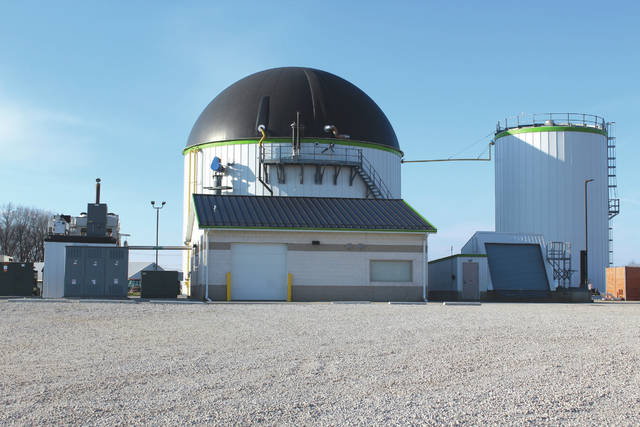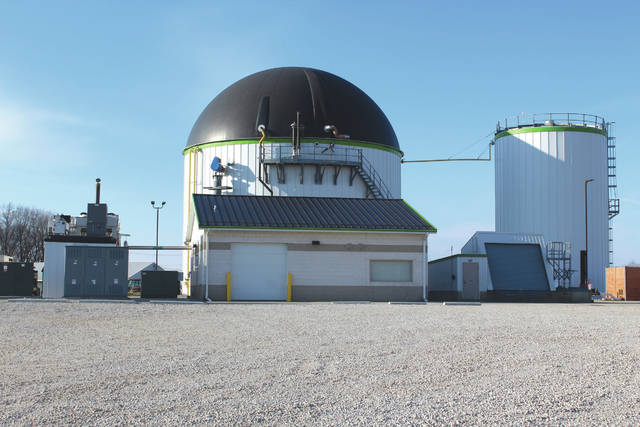

Editor’s note: This is the second part in a series of three storiest that highlight the use of biosolids in Bath Township and resident concerns.
BATH TOWNSHIP — The Ohio Environmental Protection Agency is hosting a public hearing 6 p.m. Thursday, March 22 at the Howard Conference Center in the Greene County Career Center, 2960 W. Enon Road in Xenia, regarding a permit application to expand operations at a Bath Township farm where renewable energy is produced.
However, the permit application has raised many concerns for some Bath Township residents, including Ron and Kassie Lester, who reside on the 700 block of Herr Road. The group of concerned citizens plans to attend the public hearing to voice their opposing views. Among their complaints are the nuisance odors of transported and spreading biosolids, as well as the lasting effects the waste could have on residents’ drinking water, health and safety.
Lester said the most common complaint among the residents who live near the facility is the foul odor that wafts across the rural area from the farmland where the liquid biosolids are spread, which she noted has turned country living into a very unpleasant experience.
“The odors have existed since 2014 when this facility started its operation, and there have been several complaints made to the Ohio EPA regarding the odors. The odors are worse when the land applications are taking place, but there is still an odor from the open-top sewage lagoon every day,” said Lester. “Some residents had to cancel their Easter plans this past year at their homes due to the obnoxious odor outside.”
In early February, the Ohio EPA investigated a complaint about the foul odor emitting from the farm but found no violations, according to Ohio EPA Spokeswoman Dina Pierce. Pitstick further explained that the decomposition of tillage radishes was the source of the odor at that time, and he noted that the odor would continue into the spring as the radishes decompose.
The posting of signs in neighboring farms fields, designating the fields as Ohio EPA authorized Class B biosolids beneficial use sites, spurred Lester to research available information about biosolids and their effects on public health and quality of life near land application sites, including residents’ reports of headaches, burning eyes, nausea, vomiting, diarrhea, upper respiratory problems, sinus congestion and skin infections at the time of exposure.
“I have received the same type of complaints after speaking with residents who live around the fields where the Class B biosolids are applied. People with asthma and COPD have the most difficulty breathing during times of land application and for a period of time afterwards,” said Lester.
Yet, Alexander Ringler, chief executive officer at Renergy Inc., noted that the township facility has ISO (International Organization for Standardization) 9001 and 14000 certifications, which are the international standards that specifies requirements for an effective quality and environmental management system.
“Bio-filters were implemented during the construction of the facility that are permitted and comply with all applicable regulations,” Ringler said. “Our staff is also committed to following standard operating procedures to mitigate environmental impacts.”
Lester also expressed her concerns about the location of a 5-million gallon, open-top lagoon at the farm that stores the digested fertilizer product until it is applied to the farm fields. The lagoon is located near a quarry where blasting takes place and overlies shallow sand and gravels that have been defined as a sole source aquifer.
“The lagoon is only one-half mile away from several township residents’ drinking wells. If the blast from this quarry can leave cracks in houses, what is it doing to this lagoon?” Lester questioned. “There is also evidence from the Ohio Department of Natural Resources Department of Geologic Survey that sink holes exist within this region.”
However, Bath Township Trustee Tom Pitstick said no real threat of a leak could exist from the storage lagoon because the tank is a concrete structure that consists of several safety features to minimize any hazards.
“The walls are 16-inch thick, steel reinforced, and the tank has a drain tile around the 2,000-yard concrete base that is regularly monitored for any leakage,” said Pitstick. “The fertilizer product that is produced is mostly free of pathogens that can cause disease.”


